Chapter 12. Calling for Help
In This Chapter:
- Understand Vista’s Help and Support window
- Differentiate between local and online help
- Maximize your use of the Help and Support window’s toolbar
- Ask Microsoft a question
- Search the massive Knowledge Base
- Request or offer remote assistance
- Use Windows Communities
- Understand application-based help
This chapter shows you how to help yourself. That is—how to help yourself find help that you need as you use Windows Vista.
This book is really all you’ll ever need to use your computer effectively (humility was never a problem with your author). But when you get confused, as might happen at times when something doesn’t go the way you expect it should, Vista offers an extraordinary set of tools that you can access to find out how to accomplish a specific task. If you’ve recently upgraded to Vista from a previous version, you will notice that Microsoft added a lot to the Windows help system.
Introducing Vista’s Help and Support
Even Windows experts need help with Windows every now and then. Windows is simply too vast, despite its simple appearance and clean desktop, for users to know everything about the system. Windows Vista includes a powerful built-in help system, which can connect to the Internet when needed so that in addition to the built-in help on your disk, there’s also up-to-the-minute help available from Microsoft’s website.
Help is available whenever you need it. For example, if you’re working within a Windows Explorer window and have a question, just search the online help system for the words Windows Explorer and Windows gives advice about how to use Windows Explorer.
Microsoft calls the Windows Vista help screens the Help and Support window (or sometimes the Help and Support Center). The Help and Support window goes far beyond the standard online help you might be used to in other applications.
You can request help in a number of ways while working in Windows Vista. And there are numerous places from which you can get help. This chapter focuses on the most common ways that you can use online help and offers tips along the way.
By the Way
To use every help feature available to you in Windows Vista, you need Internet access. Microsoft keeps up-to-date advice on the Web, such as bug reports and add-on programs to Windows Vista that you can download to improve your effectiveness as a Windows user.
The taskbar is always available to you at the bottom of your screen no matter what else you’re doing in Windows. Even if you’ve hidden the taskbar behind a running program, the taskbar is available as soon as you press your Windows key to display the taskbar and Start menu.
You’ll find Vista’s Help and Support command on your Start menu’s right pane. Selecting Help and Support displays Figure 12.1’s Help and Support window.
Figure 12.1. The Help and Support window offers all kinds of help.
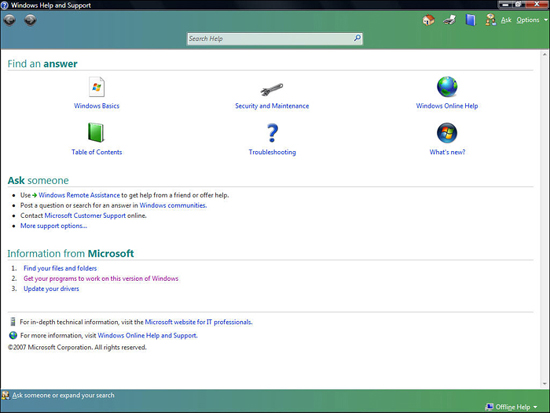
Don’t worry if your Help and Support window looks slightly different from the one pictured in Figure 12.1. Depending on which Vista upgrades and service packs have been installed on your system, along with other factors such as your computer vendor (who might have customized the Help and Support window with its logo), there is often variation in how the Help and Support window appears.
The Help and Support window offers two kinds of help:
- Local help that searches your PC’s help files for answers to your questions
- Web-based help that provides a vast resource of help from Microsoft’s online site
Did you Know?
As with most of Vista’s Explorer-like windows, the Help and Support window contains a toolbar that works like a web-browsing toolbar. As you move through the help screens, you can click the Back button to back up to something you read earlier. Click the Forward button to return.
The great thing about Vista’s help being both local and online is that you aren’t limited to your own system help files. Although you can get many answers from your PC’s local help files, Microsoft’s online help window makes it easy to get the latest answers you need.
Obviously, you need to have an Internet connection to use the online help. Most readers of this book have that; however, if your connection is dial-up and not an always-on, high-speed connection, the effectiveness of the online help will be diminished slightly. If you’re not logged on to the Internet when you need to get online help, your computer must first dial in to your service provider to connect to the Internet. When that process is complete, Vista can locate the help files you need and download them. If the files are graphical, as many are, they will be slow to load on a dial-up connection. You certainly will benefit from the online help but the connection to it won’t be as seamless as if you had an always-on Internet connection.
Did you Know?
If you use dial-up and don’t want Vista to search online automatically every time you request help, you can request that Vista search only your local disk space when providing routine help. The section, “The Help and Support Window Options” later in this chapter, explains how to set Vista’s help system to search only your local machine when you request help.
If you’ve used Windows Help in the past, you’re likely to notice at least one omission. Unfortunately, Windows Vista’s Help and Support window does not support a History button on the toolbar atop the screen as previous versions of Windows did. The next time you have Bill Gates over for dinner, you should ask him why he removed that helpful feature.
Using the Help and Support Window’s Toolbar
Figure 12.2 shows the toolbar that resides atop your Help and Support window. You will use the Help and Support window toolbar quite a bit as you traverse Vista’s help system.
Figure 12.2. You’ll use the Help and Support window’s toolbar quite a bit.

In the upper-left corner are the Back and Forward buttons described in the previous section. In the upper-right corner reside the rest of the help buttons. The following sections explain the use of each button.
Help’s Home Button
When you click the Home button from any help page, Vista displays the original Help and Support window again. This is a quick way to return to the top-level help page on your system without having to click Back over and over to get back to the original Help and Support window or opening the Start menu to display the first Help and Support window again.
Help’s Print Button
Anytime you want to print a help page you’ve displayed, click the Print button. Vista opens the Print dialog box from where you can print that page.
Help’s Browse Button
When you click the Browse toolbar button, the Help and Support window changes to show you all the top-level topics on your computer’s local help system (see Figure 12.3).
Figure 12.3. The Browse button produces a window of high-level help topics.
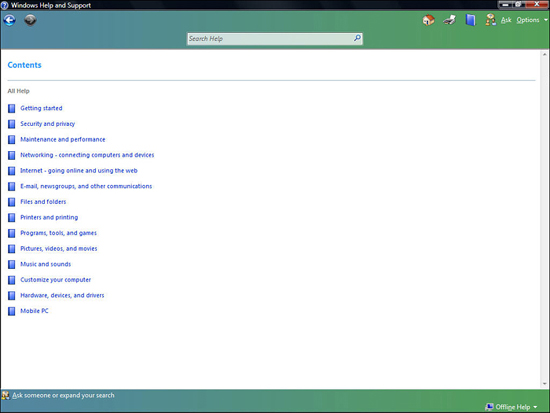
When you have a general question, the browsed topic list is often a good place to begin. For example, assume that you just got a music CD and you want to send the CD’s music to your computer’s hard disk—called ripping—to play while you work. Although you could search the help system for CD and music and ripping, you’ll get a better introduction to using your computer’s CD player to rip music by browsing the topic called Music and sounds. That high-level, music-related topic gives you a much better introduction to ripping CD music than a search for the specific word ripping would.
Help’s Ask Button
Perhaps the most powerful of all the Help and Support window features is the Ask button. When you click Ask, the Help and Support window changes to display the Get Customer Support or Other Types of Help window as shown in Figure 12.4.
Figure 12.4. A massive amount of personalized help is available to you here.
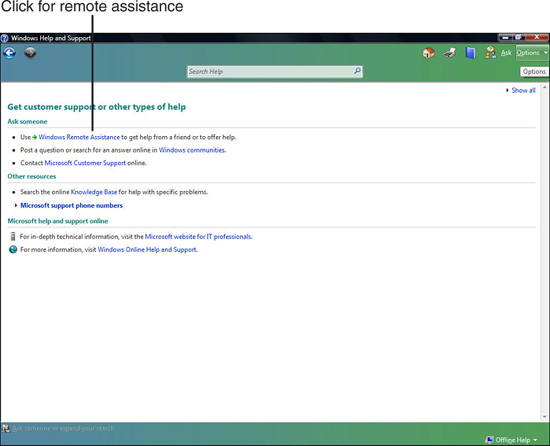
By the Way
The Ask Someone window’s list of help contacts also appears in the lower-half of the Help and Support window’s home page.
The Ask button puts you in touch with personalized, third-party assistance and Internet-based information that can help you get past problems.
Contacting Remote Assistance
When you have a problem with your computer, wouldn’t it be nice to ask an expert to look over your shoulder and explain what’s going on? In a way, Windows Vista does just that.
When you click the Windows Remote Assistance link, you gain access to a system that allows others connected to your computer via the Internet or local network to temporarily take over your computer from their own Windows desktop. This allows them to see your display and work with any running applications with the goal of finding a solution to whatever problem you have.
Remote Assistance is one of the most innovative features of Vista’s help system. When you click the Windows Remote Assistance link, you’ll see the screen shown in Figure 12.5, which explains what will occur when you make a connection with a remote user.
Figure 12.5. Anther user can connect directly to your computer and run your programs remotely to locate problems.
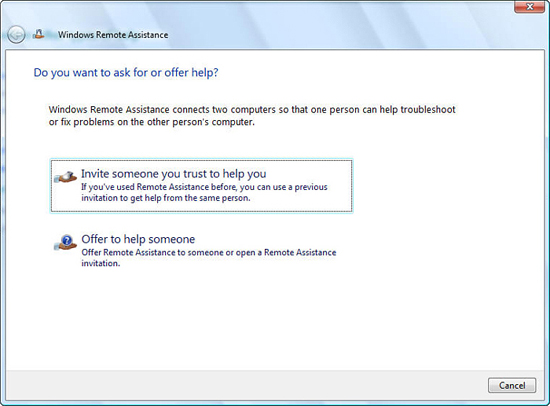
During the remote session, you and the remote user are able to chat in a pop-up chat window. You’ll use the chat window to explain what is happening and to answer questions the remote user has.
Watch Out!
Your remote user must be using Windows Vista or Windows XP, and must also have Internet access or access to your computer through a local area network. Some computers that you might connect to might have firewalls attached that add security from unauthorized break-in attempts. Such firewalls sometimes wreak havoc with the Remote Assistance feature. You and the remote user must be able to modify or temporarily disable firewall settings if this occurs to allow the remote access. Because this is done differently for all of the kinds of hardware and software firewalls available, you’ll have to check the firewall’s documentation to learn how to do this. (Although it can be easier to simply disable your firewall rather than reconfigure it to allow Remote Assistance to run, you should avoid doing so if at all possible.)
So many variations of equipment and connections exist that it would be virtually impossible to walk you through the steps that would work in all readers’ cases. Nevertheless, the general steps that you must take to connect to a remote user are fairly common. Here are those general steps you’ll go through when using Remote Assistance:
- Display the Help and Support window.
- Click the Ask button on the Help and Support window’s toolbar.
- Click the Windows Remote Assistance link.
- Click the Invite Someone You Trust to Help You link. Before connecting to a remote user, you have to send that user an invitation to connect to your system. As Figure 12.6 shows, you can send an invitation as an email link or save the invitation in a file that you then must attach to an email and send to your remote user. (The latter approach is required if you use a web-based email service such as Hotmail.) You can also save or copy the file to a remote user over a network folder, or save it to a disk that the remote user can then read to make the remote connection. The file contains instructions that the remote user’s computer can understand to connect to your computer.
By the Way
You must type a password twice and your remote user must know that password before any computer can connect to your computer. This ensures that if the file falls into the wrong hands, the owner of those hands won’t be able to use the file to access your computer.
Figure 12.6. The Windows Remote Assistance window offers two ways to send an invitation to a remote user.
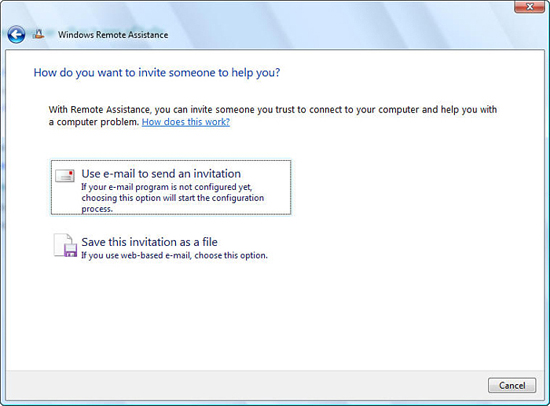
- After the remote user responds to your invitation and agrees to help you out by clicking the appropriate link on the remote computer, Windows Vista connects your machine to the remote user. At that time, the remote user can watch everything you do on the remote computer’s screen. You can chat back and forth and if you’ve been getting an error that you don’t understand, the remote can see everything you do to generate that error and might be able to help you around the problem.
By the Way
During the remote session, you’ll notice only two differences from normal Windows operation. Your desktop background will be blank. To help keep the connection as fast as possible, Vista temporarily hides any desktop background image you may have selected. In addition, a remote session window will be available to you. Using this window, you can send a file to the remote user, start and stop a chat session, and terminate the remote connection when you finish.
Watch Out!
Don’t send an invitation to a remote user you don’t trust. Obviously the ability to access your computer’s resources is not a gift you’d offer to someone you don’t know or isn’t a representative of a trustworthy support operation. More and more software and hardware firms will surely offer remote assistance through Vista’s Remote Assistance service. Generally, if you initiate the session, your files should be fine as long as you know, or trust, the remote user. You can terminate the remote session any time you want.
Using Windows Communities
Instead of getting help from someone in particular, as you do with Remote Assistance, you can request help from Microsoft-based websites and other online areas of chat and email related to Vista.
When you click the Windows Communities link, your web browser opens to the screen shown in Figure 12.7. Here you can access Microsoft Windows Vista newsgroups, a gathering of people from both Microsoft and its customer base who chat, post files, and troubleshoot problems.
Figure 12.7. Search Microsoft’s newsgroups for answers you need.

By the Way
A newsgroup is like a community bulletin board. Chapter 41, “Accessing a World of Information in Newsgroups,” explains more about newsgroups and how to use them.
Type a word or phrase that describes your problem in the Search For text box and click the Go button to see the newsgroup information related to that search topic. To the left of the newsgroup web page, you’ll see a list of Vista-related newsgroups that you can explore.
Contact Microsoft Support
Click the Contact Microsoft Support to open link and the web page shown in Figure 12.8. On this website are the various ways you can contact Microsoft for additional help, from email support to phone support.
Figure 12.8. Sometimes you need to contact Microsoft to get an answer.
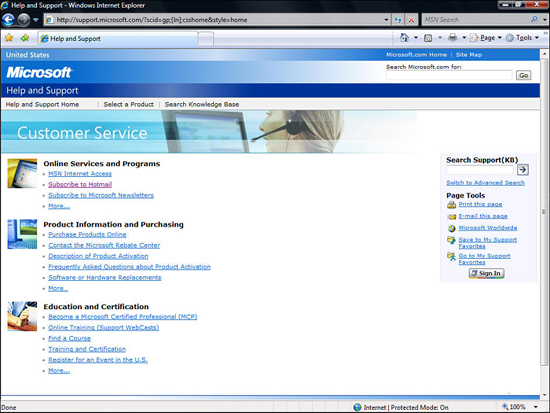
Watch Out!
Not all the contacts on the Microsoft Support page are free. Some cost money, such as some of Microsoft’s phone-related support contacts.
Did you Know?
If you know you want to call Microsoft Support for something, you don’t have to search the Support web page to locate phone numbers. Instead, click the Microsoft Support Phone Numbers link on the Ask page of the Help and Support window and a list of numbers will appear.
Search Microsoft’s Knowledge Base
Knowledge Base is a specific location on Microsoft’s website that holds the largest repository of helpful information about Windows Vista you can find. In addition, Microsoft’s Knowledge Base contains a massive amount of information on all of Microsoft’s products.
When you click the Search Knowledge Base link, Vista takes you to Microsoft’s online Knowledge Base website shown in Figure 12.9. Here you select the product for which you want help, and type a phrase for which you want to search, in hope of getting help on a problem.
Figure 12.9. Microsoft’s Knowledge Base is a massive database of help topics with tens of thousands of articles.
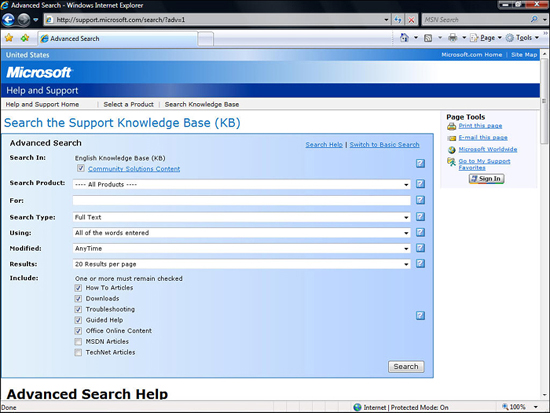
For example, if you cannot get Vista to recognize an old CentStar LP5 dot-matrix printer that you’ve connected to your computer, you might want to search Knowledge Base for the search phrase CentStar LP5 or dot-matrix and see whether anybody in the past has run across or solved your problem. (By the way, there is no printer company named CentStar, so you won’t find anything on that if you’re following along on your keyboard. You can search the Knowledge Base for something else.)
Additional Online Help
You’ll find two additional online help resources on your Ask page.
If you’re an IT professional, such as a programmer or Network Engineer, you might want a more technical and specialized help and support location. Click the link labeled Microsoft Website for IT Professionals to go to a page geared toward and run by a more technical crowd than the average PC user.
In addition, if you click the Windows Online Help link, Vista sends you to the more general Vista help page shown in Figure 12.10. Here you’ll find a well-structured website that you can dig down into for extremely specific and technical advice, but also a website that is better organized than the IT Professional website.
Figure 12.10. The Windows Vista Help and Support web page contains the most general interface of all the Vista help sites.
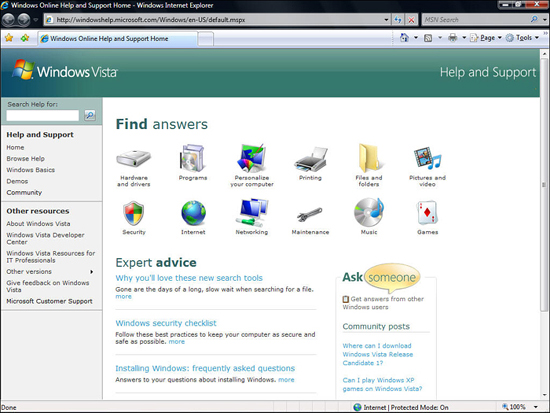
The Help and Support Window Options
A few options are available when you click the down arrow next to the Options button on your Help and Support window toolbar. Most are self-explanatory but a couple of them are extra useful.
On some monitors, your help screens might display text that is too small to read. Depending on your graphics card’s resolution, you might have to enlarge the text on your help screens to make it more readable. To increase the text size (or decrease it if too little of the help screen shows), click to open the Options menu and select Text Size. You can change the text size from Largest to Smallest; the default is Medium.
Another option you might want to select is the Settings option, which displays the Help Settings dialog box shown in Figure 12.11.
Figure 12.11. The Help Settings dialog box enables you to set two specific Vista help settings.
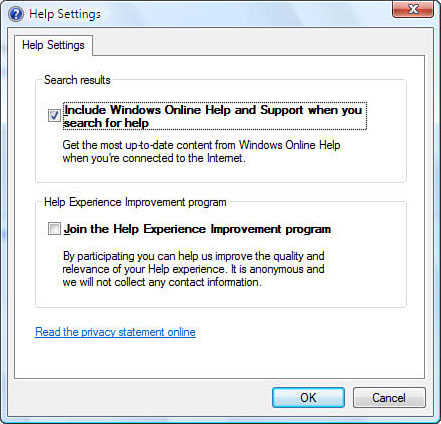
By clicking to uncheck the top option, Vista no longer searches online when you request help from within the Help and Support window. This option is most useful for dial-up users without high-speed broadband connections who don’t want to connect to the Internet every time they request help.
The second option turns on Microsoft’s Experience Improvement program. When you get help on a topic, Microsoft might send certain information about your request and your machine to the Microsoft servers. By collecting the most common problems, Microsoft is better able to provide updates that can help users avoid those problems in the future. The information that goes to Microsoft is anonymous.
Did you Know?
There’s an even faster way to request that Vista offer local-only help or both local and online. Click the Online Help button in the Help and Support window’s lower-right corner and click either the Get Online Help option or the Get Offline Help option depending on whether you want Vista to use the Internet to provide help.
Other Forms of Help
The help you obtain in Windows Vista does not always come from the help system itself but from auxiliary help systems that adds support to the programs with which you work.
Using Application Help
When you use a Windows Vista program, you often need help with the program rather than Windows. Almost every application’s menu bar includes a Help option that you can click for help with the program.
For example, if you select Help, Help Topics from the Vista Calculator program, a help dialog box appears for Calculator. The help is fairly standard and looks and works a lot like Vista’s help system in that the help is link-based and you can traverse the help topics back and forth just as you might a web page.
In addition, a search box appears at the top of each application’s help window. When you type a topic or term in the search box for which you want help, the help system will search only the Calculator-based help. Therefore, application-specific help searches search only that application’s help files.
Some applications you run will have been written before Vista appeared on the market or perhaps the software authors decided not to follow Vista’s exact requirements for software development. In those cases, you are likely to run across help windows that look more like the help windows in previous versions of Windows, such as the one shown in Figure 12.12.
Figure 12.12. Some programs produce more traditional help windows that were more common in pre-Vista Windows versions.
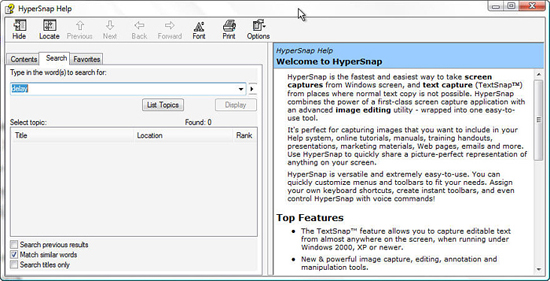
On these older Help dialog boxes, you’ll find three tabs at the top of the screen with help divisions called Contents, Search, and Favorites (and possibly others). The Contents pages offer a general overview of the program. The Search tab enables you to search for specific help topics on that program.
Vista’s Guided Help
A powerful help feature you’ll also find embedded within many of Vista’s help screens is the guided help feature. Guided help will actually perform an action for you, such as open a window or start a program that you need help with.
For example, if you click your Start menu’s Help and Support button and type defrag in the Search box, you’ll see a list of help topics related to Vista’s disk defragmentation program. Selecting the Start Disk Defragmenter option opens Figure 12.13’s help screen. Not only does the help screen explain how to start the Disk Defragmenter program, the help screen provides a link that opens the Disk Defragmenter program for you. By clicking the link, therefore, you don’t have to follow the start instructions under the Note section to start the program.
Figure 12.13. Vista’s guided help actually starts programs and opens windows for you when needed.
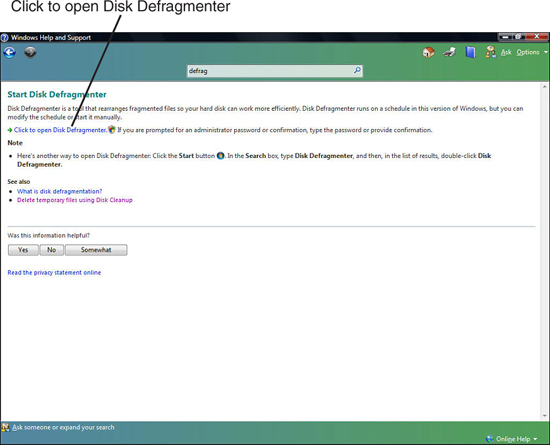
By the Way
The Disk Defragmenter can only be run by a user with Administrative user account privileges, so you’ll have to confirm your Administrator user account before you can run the program even if the guided help system is the reason the program is starting.
Chapter Wrap-Up
This chapter showed you how to access Vista’s powerful Help features. When you have a question about Windows Vista, you can ask Vista for help. There are several ways to access the helpful dialog boxes that cover a variety of topics. The most common way is to open the Help and Support window from your Start menu. You can access your PC’s local files, search the Internet for answers you need, or ask a remote user to look at your problem. Most Windows programs contain a Help command that displays a tabbed dialog box containing different kinds of help search screens.
In the next chapter, you’ll become a master at searching for information on your computer. Windows Vista’s power search boxes appear in several places so that you can locate what you want when you want it. With disk drives so much larger than ever before, being able to locate information quickly is more critical than ever.
